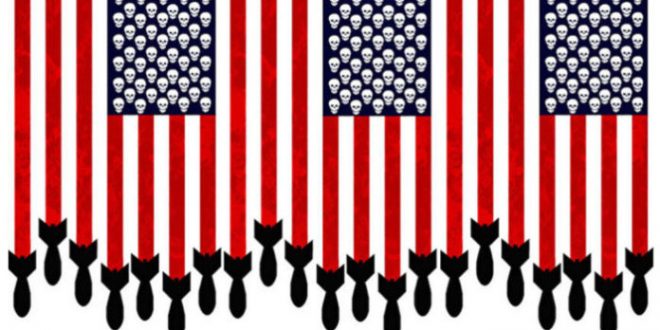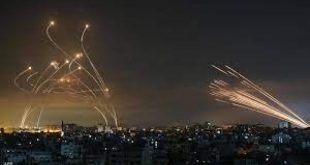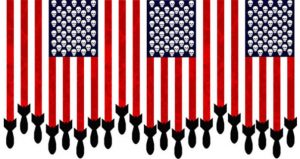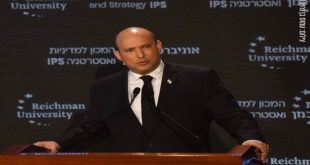“There are two ways to approach the study of terrorism,” notes Noam Chomsky in ‘Western State Terrorism’. “One may adopt a literal approach or a propagandistic approach, construing the concept of terrorism as a weapon to be exploited in the service of some system of power. It comes as no surprise that the propagandistic approach is adopted by governments generally, and by their instruments in totalitarian states.”
The ominous threat of ‘international terrorism’ does not come from some teeny-weeny, ruthless jihadist cluster, but from the Western nuclear powers that form the core of the NATO alliance, and keep issuing vile threats against countries that don’t subscribe to their warped worldview.
Just a few days ago, the madman in the White House, in an incoherent bluster, threatened the Islamic Republic of Iran, while responding to a tweet of Iranian President Hassan Rouhani. “Never, ever threaten the U.S. again or you will suffer consequences the likes of which few throughout history have ever suffered before,” Trump tweeted to Rouhani, who had earlier politely advised the former not to “play with the lion’s tail”. Iranian foreign minister Javad Zari shot back, saying the Iranians have heard such “bluster” for 40 years, and still been around for millennia and seen fall of empires. Trump knew he had used the wrong card, because terrorism and war crimes are associated with the U.S., not Iran.
Perhaps Trump and his cohorts need lessons in history, to be reminded of the horrific crimes his country has committed across the world throughout history. The history of U.S. imperialism is replete with stories of unilateral belligerent military strikes, gory massacres and socio-cultural aggression. At the receiving end have mostly been those who refused to pledge allegiance to the American hegemony.
This blatant chauvinism and sinister desire to inflict suffering on others is best explained by these words of American writer Andre Vltchek. “West has always behaved as if it had an inherited, but undefined, right to profit from the misery of the rest of the world. In many cases, the conquered nations had to give up their own culture, their religions, even their languages, and convert to our set of beliefs and values that we defined as ‘civilized’.”
Let’s briefly recap some of the crimes the U.S. war machinery has been directly or indirectly complicit in. Guatemala Civil War that continued from 1960 to 1996 was bitterly fought between the government of Guatemala and various rebel groups, mostly the ethnic Mayans. The government of Guatemala committed worst human rights abuses and engineered genocide of Mayan population of Guatemala, resulting in the killing and enforced disappearance of about 200,000 people – mostly civilians, with the tacit support of CIA.
Direct or indirect support for death squads has been an integral part of CIA operations. CIA’s death squad operations in Vietnam War, which dominated 30 long years of Vietnam’s history from 1940s to 1970s, led to killing of over 35,000 people. More than 20,000 Vietnamese were killed during the CIA-guided Operation Phoenix intended to weed out communist ‘agents’ from South Vietnam.
The U.S. role in the violent overthrow of the democratically-elected Popular Unity government of Salvador in 1980s resulted in 70,000 deaths and mass human rights violations. To crush the rebels, the U.S. equipped and trained an army which kidnapped and disappeared more than 30,000 people, and presided over large-scale massacres of thousands of old people, women and children.
In a review of book ‘Nixon, Kissinger, and Allende: US Involvement in the 1973 coup in Chile’ by Lubna Qureishi, Howard Doughty makes a pertinent observation. “The United States and its allies have an unseemly history of hostility to democracy abroad that seems to conflict with their expressed political principles and their stated purpose in engaging in military and diplomatic action abroad. Not only in Latin America, but in Africa, Asia and occasionally in Europe, it has openly and clandestinely supported dictatorships.
The U.S. government’s cozy relationship with Israel is no secret. It has overtly and covertly backed Tel Aviv in occupying Palestinian territories, in blatant breach of international laws and UN resolutions. Veteran Middle East reporter Robert Fisk, in an article published in Independent in April 2001, drew parallels between Israel and the apartheid regime of South Africa.
In Cuba, America’s record is again terrible. It has been involved in attempted assassinations of state heads, bombings, military invasions, crippling sanctions et al. Even after half a century, economic blockade remains in force. The country has been designated a terrorist state, figuring prominently on the State Department’s list of ‘State Sponsors of Terrorism’.
Washington’s support for the Contra terrorists in Nicaragua between 1981 and 1990 is one of the most shameful open secrets. By acknowledging the link between the U.S. government and the contras, the terrorist activities that the contras engaged in and the recognition by the International Court of Justice, it is clearly evident that the U.S. engaged in state-sponsored terrorism in its response to the Nicaraguan revolution. Noam Chomsky writes in ‘Western State Terrorism’: “The guiding principle, it appears, is that the U.S. is a lawless terrorist state and this is right and just, whatever the world may think, whatever international institutions may declare.”
On March 8, 1985, in an assassination bid on Sheikh Mohammed Fazlullah by CIA, a powerful car bomb exploded outside a Beirut mosque in Lebanon, leaving 81 civilians dead. Celebrated investigative reporter Bob Woodward stated that CIA director William Casey had admitted personal culpability in the attack while he lay on his deathbed, which he said was carried out with funding from Saudi Arabia.
In December 1989, almost 27,000 U.S. soldiers invaded a small Central American country of Panama to arrest General Manuel Noriega, a CIA asset-turned-rebel. In the ‘Operation Just Cause’, bombs rained down on three neighborhoods – Colon, San Miguelito and El Chorillo. El Chorillo was burnt to the ground and got a new nickname – ‘Little Hiroshima’. According to the conservative estimate, between 2,000 and 6,000 people were killed in the events that unfolded.
Congo has been through violent times since its independence. Many observers and activists trace it to the murder of Patrice Lumumba, the first prime minister of independent Congo, which was apparently done at the behest by the then U.S. President Eisenhower.
In Haiti, the U.S. backed the Duvalier family dictatorship for 30 years, during which the CIA worked closely with death squads, executioners, and drug traffickers. The father-son duo’s three decades at helm was marked by brutally crushing dissent with the assistance of secret police and the Haitian army.
The 1983 invasion of Grenada was the first major American military assault since Vietnam War. The news was blocked as the U.S. government didn’t want the world to witness the great superpower bashing up a small island nation and murdering its civilians. Why did the United States invade Grenada? “Many believe that Grenada was seen as a bad example for other poor Caribbean states,” opines Stephen Zunes, author of Tinderbox: U.S. Middle East Policy and the Roots of Terrorism. “Its foreign policy was not subservient to the American government and it was not open to having its economy dominated by U.S. corporate interests.”
In Greece, America supported a coup against an elected leader George Papandreou, which followed the years of murder, torture, and fear in the late 1960s. The tyranny of a fascist-military junta had backing of United States and NATO from 1967 to 1974. As per the rough estimates, around 10,000 workers, students, political leaders and social activists were imprisoned and brutally tortured.
In Cambodia, the U.S. resorted to carpet bombing to overthrow President Prince Sihanauk, who was replaced by Pol Pot and Khmer Rouge and that led to millions of civilian casualties between mid-1950s and 1970s.
So, it should be pretty clear which the breeding ground of terrorism is. Dr Mahboob A Khawaja, who specializes in global security, peace and conflict resolution, wrote on Global Research website: “The U.S. neo-conservative gang helped to rob the mankind of its human heritage. The perception of ‘radical Islam’ was invented and enhanced by the ‘fear’ of terrorism as if Arabs and Muslims were born in the eye of the storm and terrorism was an exclusive domain of the Islamic religious tenets.”
The myth of the “outside enemy” and the threat of “Islamic terrorists” is the cornerstone of the U.S. administration’s military doctrine, used as a pretext to invade Afghanistan and Iraq, writes Michel Chossudovsky, author of ‘The Globalisation of Poverty’. And, consider the fact that in the name of fighting their enemies, the U.S. government had directly been supporting Al Qaeda and other terrorist groups for the decade before 9/11 happened.
A majority of high-ranking security experts agree that waging war in the Middle East has weakened U.S. national security and increased the threat of terrorism. A top military interrogator remarked that torture by American military of innocent Iraqis is one of the main reasons that foreign fighters started fighting against Americans in Iraq and other countries. And, it is a well-known fact that there was no presence of Al-Qaeda or ISIS in Iraq and Syria until U.S. invaded Iraq and later Afghanistan.
Marjorie Cohn, a widely-known professor of international law, in an article written in November 2001 maintained that the bombings of Afghanistan by the United States and the United Kingdom were illegal. Afghanistan did not attack the United States. Indeed, the 19 men charged with the crime were not Afghans. There were reports indicating that the United States had made the decision to invade Afghanistan two months before the 9/11 attacks.
Twelve years down the line, the foreign military troops are still stationed in Afghanistan, hundreds of billion dollars have been spent, and at least 31,000 people in Afghanistan (civilians, insurgents, Afghan military forces, and others) have been killed in America’s longest war.
Now, America’s involvement in Yemen and Syria has again raised many eyebrows. In Yemen, Washington has extended full support to Riyadh’s war crimes and in Syria, America has been supporting foreign mercenaries, resulting in incalculable death and destruction.
Talking of Iran, more than a decade after U.S. invaded the country, it’s still not clear why they did it. It’s a fact, even acknowledged by the Western media that the war for Iraq was a war for oil. Stephen Zunes, professor of politics at the University of San Francisco, believes that even more than a decade after Iraq debacle, U.S. has not learnt its lessons. “Despite all this, some of the same politicians in Washington who pushed us into war a decade ago are trying to do so again. This time, with Iran,” says Zunes. “Once again, then, we have a bipartisan group of senators pressing for war against an oil-rich Middle Eastern nation, exaggerating the alleged threat, refusing to consider the consequences of war, and dismissing the caution of experts.”
Back in 1953, a joint British-American operation toppled the democratic government chosen by the Iranian parliament, and installed their loyal dictator. “The coup restored the Shah to absolute power, initiating a period of 25 years of repression and torture, while the oil industry was restored to foreign ownership, with the US and Britain each getting 40 percent.” Again, the shadowy forces are working overtime to nail Iran, employing war rhetoric, brinkmanship, sabre-rattling. But, Iran stands firm, ready to defeat all the sinister designs.
 WILAYAH NEWS VOICE OF THE GLOBAL AWAKENING
WILAYAH NEWS VOICE OF THE GLOBAL AWAKENING







